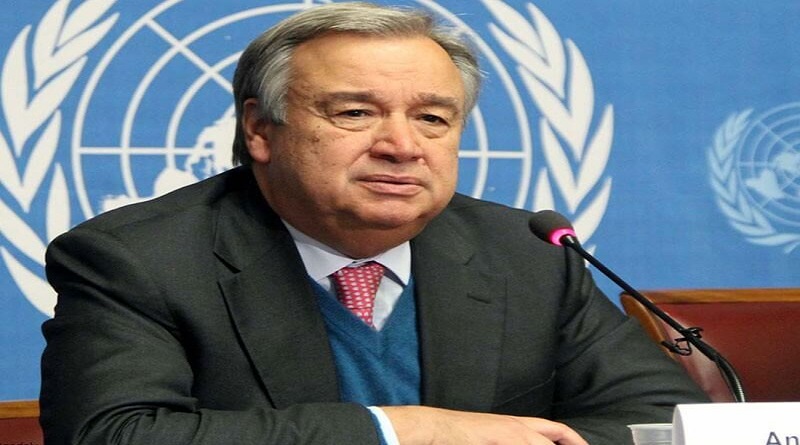Everything has to change for our planet to stay the same- UN chief
Our planet is changing dramatically. Forests are burning, sea ice is shrinking and the Greenland icecap is pouring unprecedented amounts of water into the ocean. Levels of carbon dioxide in the atmosphere are higher than they have been in human history, climate disruption is the new reality, and scientists are warning that the planet is simply not capable of coping with the growing pressure being placed on it by humanity.
Since I became Secretary-General, I have witnessed what it means to live in a world that is, on average, one degree Celsius hotter than it was before the industrial revolution. I have come to know the dramatic force of natural disasters supercharged by climate change.
I have seen families in the tiny Pacific archipelago of Tuvalu watching the sea creep closer and closer to their doorsteps. I have seen my own country, Portugal, mourn the deaths of over 100 people killed by forest fires during one of Europe’s hottest recorded summers. And I have seen children in Mozambique learning their ABCs in the scorching sun after the roof of their school had been swept away by Cyclone Idai, along with 90 per cent of their city’s infrastructure. While there, I also visited a safe place for women in a displacement camp, which highlights the double jeopardy women face in times of disaster, where their losses are often compounded by vulnerability to violence.
The human suffering caused by the global climate emergency is already massive and growing daily, yet science tells us that it is nowhere near as calamitous as what our children will experience if we add another degree of global heating. Science also tells us that we are currently on track to add a further two or more degrees within the lifespan of our grandchildren – a legacy of almost unfathomable ruin, and one we must do everything to avoid.
Despite the daily diet of grim news, there is still hope. According to the Intergovernmental Panel on Climate Change, we can win the race against time that the climate crisis has become. But to do so, we must take transformative action now and implement “rapid, far‑reaching and unprecedented changes in all aspects of society,” around the globe.
That is why I have been asking for bold announcements from governments and businesses at the Climate Action Summit that I am convening at United Nations Headquarters on 23 September. I am calling on countries to shift taxes from people to pollution, end fossil fuel subsidies and stop building new coal power plants by 2020. These are the first steps we must take to slow down runaway climate change before it breaches the most dangerous thresholds. We need to cut greenhouse emissions by 45 per cent by 2030, and we need carbon neutrality by 2050.
To contain global heating, we will have to overhaul the way our societies and economies function, from energy, transport and industry to how we farm and eat. It will require protecting and restoring our forests and oceans, and delivering clean, affordable energy to everyone. It will also demand gender equality, universal health coverage and quality education for all.
It is here that climate change also presents compelling opportunities. The best plan to solving one of the world’s biggest threats is one we already have: the 2030 Agenda for Sustainable Development, the universally agreed path to the future we want and need. The 2030 Agenda, with its 17 Sustainable Development Goals, recognizes that global challenges such as climate change, poverty, hunger and inequality require a holistic transformation, and is our best tool for ensuring that the dramatic transition we need will be just and fair.
This month, world leaders will gather in New York for a week of critical meetings to accelerate action for sustainable development, including the Climate Action Summit and the SDG Summit. I have asked leaders to announce concrete plans of action that can boost global ambition.
The Italian author, Giuseppe Tomasi di Lampedusa once wrote that “if we want everything to stay the same, everything must change.” If we want our planet to remain the same – healthy and able to support prosperity and opportunity for all — we will have to completely transform our world. I count on leaders everywhere to heed this call and rise to the challenge of their 2015 promise to deliver a sustainable future for this and future generations.
A world on the move – UN DESA reveals latest data on international migration
We live in a world on the move. Across the globe, there are persons who choose to leave their home countries in search of a brighter future with greater opportunities for themselves and their families. In some countries, people have been leaving their home also to escape dangerous conditions, whether naturally occurring or manmade.
In 2017, the world counted 258 million international migrants, representing 3.4 per cent of the global population. But what is the latest tally and what does it say about people on the move today? Stay tuned for the latest migration data to be launched by UN DESA on 17 September 2019.
Beyond the numbers, it is widely recognized that migration has major impacts on both the people and the places involved. When supported by appropriate policies, migration can contribute to inclusive and sustainable development in both origin and destination countries, while also benefitting migrants and their families. The crucial linkages between migration and development, highlighting the opportunities and challenges that migration brings, have been acknowledged both in the 2030 Agenda for Sustainable Development and the Global Compact for Safe, Orderly and Regular Migration.
Accurate, consistent and timely data on international migration are essential for Member States to monitor progress in the implementation of the 2030 Agenda and the Global Compact for Migration. The Global Compact for Migration emphasizes the importance of data by including “Collection and utilization of accurate and disaggregated [migration] data as a basis for evidence-based policies” as the first of its 23 objectives.
Reliable data on migrants and migration are crucial for assessing current and future trends, identifying policy priorities, and making informed decisions. Reliable data on international migration can also help ensure that discussions on migration, at both national and international levels, are based on facts, not myths or misperceptions.
Every two years, the Population Division of the Department of Economic and Social Affairs issues new global estimates of the number of international migrants for all countries and areas of the world, disaggregated by age, sex, country of origin and country of destination. The latest estimates of the number of international migrants are included in the International Migrant Stock 2019.
The 2019 release of the international migrant stock dataset will be accompanied by several related publications based on the new estimates. These include: (i) a policy brief providing key facts about global and regional levels and trends in international migration; (ii) a wall chart providing country-level data and regional aggregates; and (iii) country profiles providing a snapshot of migration levels and trends for each country or area.
Additional information about the international migrant stock datasets and related publications is available on the website of UN DESA’s Population Division.
By António Guterres, Secretary-General of the United Nations



